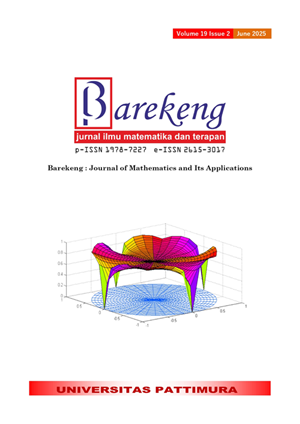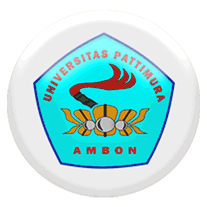NONPARAMETRIC REGRESSION MODELING USING THE SPLINE APPROACH TO STUNTING CASES IN INDONESIA
Abstract
Indonesia is the fourth ranked country in the world and second in Southeast Asia with the highest stunting cases of 21.6%. According to the provisions of the World Health Organization (WHO), the maximum tolerance standard for stunted toddlers is 20 percent or one-fifth of the total number of toddlers, so the stunting rate in Indonesia is still relatively high. The high stunting rate in Indonesia can affect the quality of Indonesia's human resources, so early detection and immediate management of stunted toddlers are needed. Stunting is a condition of failure to grow due to chronic malnutrition which is caused by inadequate nutritional intake for a long time, resulting in being shorter than standard. This research aims to determine several factors that influence stunting in toddlers in Indonesia using the nonparametric spline regression method with one knot, two knots, three knots and the best model is found to be the one knot model. The results of regression nonparametric spline modeling with one knot are GCV of 14.32605 and of 81.1%. From the five variables, namely toddlers receiving complete basic immunization babies receiving exclusive breast milk for 6 months , babies born receiving IMD children aged 6-23 months consuming five of the eight food groups and drink throughout the day , households having access to proper sanitation , the following results were obtained: the variable that don’t have a significant effect was toddlers receiving complete basic immunization , while the other four has a significant effect.
Downloads
References
M. R. Nugroho, R. N. Sasongko, and M. Kristiawan, “FAKTOR-FAKTOR YANG MEMPENGARUHI KEJADIAN STUNTING PADA ANAK USIA DINI DI INDONESIA,” J. Obs. J. Pendidik. Anak Usia Dini, vol. 5, no. 2, pp. 2269–2276, 2021, doi: 10.31004/obsesi.v5i2.1169.
Kementerian Kesehatan Republik Indonesia, “BUKU SAKU : HASIL SURVEI STATUS GIZI INDONESIA (SSGI) 2022,” Kementeri. Kesehat. Republik Indones., pp. 1–7, 2023.
World Health Organization, World Health Organization. Reducing stunting in children: equity considerations for achieving the Global Nutrition Targets 2025. World Health Organization; 2018. 2018.
A. Efendi, Microsoff Excel : PENGOLAHAN DAN ANALISIS DATA + CD. Penerbit Salemba.
R. Kurniawan and B. Yuniarto, ANALISIS REGRESI DASAR DAN TERAPANNYA DENGAN R, 1st ed. Jakarta: Kencana, 2016.
A. Efendi, N. Wardhani, R. Fitriani, and E. Sumarminingsih, ANALISIS REGRESI : TEORI DAN APLIKASI DENGAN R. Malang: Universitas Brawijay Press, 2020.
A. Fernandes and Solimun, METODE ANALISIS DATA PENELITIAN. Malang: Universitas Brawijay Press, 2022.
N. Chamidah and B. Lestari, ANALISIS REGRESI NONPARAMETRIK DENGAN PERANGKAT LUNAK R. Surabaya: Airlangga University Press, 2022.
Zulfikar and I. N. Budiantara, MANAJEMEN RISET DENGAN PENDEKATAN KOMPUTASI STATISTIKA. YOGYAKARTA: DEEPUBLISH, 2015.
R. EUBANK, SPLINE SMOOTHING AND NONPARAMETRIC REGRESSION. New York: Camridge University Press, 1988.
M. K. Dewi, “PEMODELAN KEMISKINAN DI PROVINSI JAWA TIMUR MENGGUNAKAN REGRESI NONPARAMETRIK SPLINE,” Jember, 2022.
Kemenkes RI, “KEMENKES RI NO HK.01.07/MENKES/1928/2022 TENTANG PEDOMAN NASIONAL PELAYANAN KEDOKTERAN TATA LAKSANA STUNTING,” 2022.
Kemenkes RI, “KEMENKES RI NO 2 TAHUN 2020 TENTANG STANDART ANTROPOMETRI ANAK,” 2020, doi: 10.7476/9788575415894.0004.
Badan Pusat Statistik, “PROFIL KESEHATAN IBU DAN ANAK TAHUN 2022,” Jakarta: BPS, 2022.
Badan Pusat Statistik, “SANITASI LAYAK,” BPS, 2022. https://bps.go.id/subject/29/perumahan.html#subjekViewTab1
R. E. Walpole, PENGANTAR STATISTIKA, Edisi ke 3. Jakarta: PT. Gramedia Pustaka Utama, 1995.
R. Eubank, NONPARAMETRIC REGRESSION AND SPLINE SMOOTING, 2nd ed. New York: Marcel Dekker, 1999.
H. Wu and J.-T. Zhang, NONPARAMETRIC REGRESSION METHODS FOR LONGITUDINAL DATA ANALYSIS. United States: Wiley Interscience, 2006.
I. Sriliana, I. N. Budiantara, and V. Ratnasari, “THE PERFORMANCE OF MIXED TRUNCATED SPLINE-LOCAL LINEAR NONPARAMETRIC REGRESSION MODEL FOR LONGITUDINAL DATA,” MethodsX, vol. 12, no. March, 2024, doi: 10.1016/j.mex.2024.102652.
R. Putra, M. G. Fadhlurrahman, and Gunardi, “DETERMINATION OF THE BEST KNOT AND BANDWIDTH IN GEOGRAPHICALLY WEIGHTED TRUNCATED SPLINE NONPARAMETRIC REGRESSION USING GENERALIZED CROSS VALIDATION,” MethodsX, vol. 10, no. December 2022, p. 101994, 2023, doi: 10.1016/j.mex.2022.101994.
A. Sayuti, D. Kusnandar, and M. N. Mara, “GENERALIZED CROSS VALIDATION DALAM REGRESI SMOOTHING SPLINE,” Bul. Ilm. Mat. Stat. dan Ter., vol. 02, no. 3, pp. 191–196, 2013.
S. Melinda, Sudarmin, and M. Nusrang, “PENDEKATAN REGRESI NONPARAMETRIK SPLINE TRUNCATED PADA INDEKS PEMBANGUNAN MANUSIA DI SULAWESI SELATAN,” VARIANSI J. Stat. Its Appl. Teach. Res., vol. 3, no. 2, pp. 83–89, 2021, doi: 10.35580/variansiunm23860.
W. Sanusi, R. Syam, and R. Adawiyah, “MODEL REGRESI NONPARAMETRIK DENGAN PENDEKATAN SPLINE (STUDI KASUS: BERAT BADAN LAHIR RENDAH DI RUMAH SAKIT IBU DAN ANAK SITI FATIMAH MAKASSAR),” J. Math. Comput. Stat., vol. 2, no. 1, p. 70, 2020, doi: 10.35580/jmathcos.v2i1.12460.
T. Purnaraga, S. Sifriyani, and S. Prangga, “REGRESI NONPARAMAETRIK SPLINE PADA DATA LAJU PERTUMBUHAN EKONOMI DI KALIMANTAN,” BAREKENG J. Ilmu Mat. dan Terap., vol. 14, no. 3, pp. 343–356, 2020, doi: 10.30598/barekengvol14iss3pp343-356.
Copyright (c) 2025 Mohamat Fatekurohman, Siti Nur Khasanah, Yuliani Setia Dewi

This work is licensed under a Creative Commons Attribution-ShareAlike 4.0 International License.
Authors who publish with this Journal agree to the following terms:
- Author retain copyright and grant the journal right of first publication with the work simultaneously licensed under a creative commons attribution license that allow others to share the work within an acknowledgement of the work’s authorship and initial publication of this journal.
- Authors are able to enter into separate, additional contractual arrangement for the non-exclusive distribution of the journal’s published version of the work (e.g. acknowledgement of its initial publication in this journal).
- Authors are permitted and encouraged to post their work online (e.g. in institutional repositories or on their websites) prior to and during the submission process, as it can lead to productive exchanges, as well as earlier and greater citation of published works.






1.gif)



